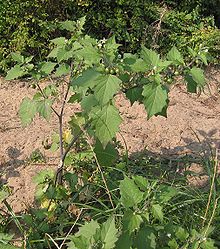Solanum nigrum
| Solanum nigrum | |
|---|---|

| |
| Scientific classification | |
| Kingdom: | |
| (unranked): | |
| (unranked): | |
| (unranked): | |
| Order: | |
| Family: | |
| Genus: | |
| Species: | S. nigrum
|
| Binomial name | |
| Solanum nigrum | |
| Subspecies | |
|
S. nigrum subsp. nigrum | |


Solanum nigrum (European Black Nightshade or locally just "black nightshade", Duscle, Garden Nightshade, Hound's Berry, Petty Morel, Small-fruited black nightshade or popolo) is a species in the Solanum genus, native to Eurasia and introduced in the Americas and Australasia.
Description
Black nightshade is a fairly common plant, found in many wooded areas, as well as disturbed habitats. It has a height of 30-120 cm (12-48"), leaves 4-7.5 cm (1 1/2-3") long; ovate to heart-shaped, with wavy or large-toothed edges.
The flowers have petals greenish to whitish, recurved when aged and surround prominent bright yellow anthers.
The fruits are oval black berries in small hanging clusters. The ripe black small fruit are directly consumable and the leaves are cooked and consumed.
Toxicity
The green berries and mature leaves contain glycoalkaloids and are poisonous to eat raw. Their toxicity varies and there are some strains which have edible berries when fully ripe.[1]
Although fatal human poisonings are rare, at least one case has been documented. The poison is believed to be solanine.[2]
Culinary usage
In India, the berries are casually grown and eaten; but not cultivated for commercial use. The berries are referred to as "fragrant tomato," or மனக்கதக்களை - manathakkaali in Tamil, and makoi in Hindi. Although not very popular across much of its growing region, the fruit and dish are common in Northern Tamil Nadu, Southern Andhra & Southern Karnataka.
In Ethiopia, the ripe berries are picked and eaten by children in normal times, while during famines all affected people would eat berries. In addition the leaves are collected by women and children, who cook the leaves in salty water and consumed like any other vegetable. Farmers in the Konso Special Woreda report that because Solanum nigrum matures before the maize is ready for harvesting, it is used as a food source until their crops are ready.[3]
Medicinal usage
The plant has a long history of medicinal usage, dating back to ancient Greece.
References
- ^ Nancy J Turner, Adam F Szczawinski, "Common Poisonous Plants and Mushrooms of North America" p.128
- ^ R. F. Alexander, G. B. Forbes, and E. S. Hawkins (1948-09-11). "A Fatal Case of Solanine Poisoning". Br Med J. 2 (4575): 518. PMC 2091497.
{{cite journal}}: CS1 maint: multiple names: authors list (link) - ^ "Wild Food" Plans with "Famine Foods" Components: Solanum nigrum (Famine Food Guide website)
There are also orange colored fruits.( by V.T.)
